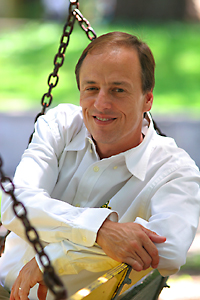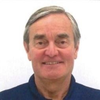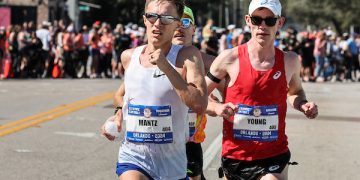 Todd Harbour, photo by Baylor University
Todd Harbour, photo by Baylor University
updated 26 February 2016
Todd Harbour is the focus of Dave Hunter’s column this week. Todd is part of a continuing column series on some of our finest coaches in the U.S.
I remember Todd’s big mile in 1981. His 3:50.34 made the papers. I also recall Todd running in the Santa Monica Track Club uniform in the years after that fine performance.
His move into coaching, first, as a high school coach, and then, to college ranks shows the quality, not only of Todd’s ability to grasp coaching technique, but also Coach Harbour’s skills in the art of coaching.
Coaching is both art and science.
As Andy Powell, Distance Coach at Oregon reminded me this past weekend, as we shared the bus to the NB Armory, “Coaches build men and women.” That is their most important job.
Enjoy David Hunter’s fine article on Coach Todd Harbour.
Leading The Way…
Todd Harbour: From Student To Teacher
Baylor’s Leader Grooming Exceptional Athletes
In sport, it is often quite difficult for those who excel as athletes to make the transition from star performer to exemplary coach. While there are exceptions [e.g. NBA champion Golden State Warrior coach Steve Kerr who has several championship rings of his own;], a large number of great athletes find it very difficult once their own accomplished athletic career is concluded to turn around and suddenly successfully mold, inspire, and direct the next generation of athletes in their sport. [e.g. Ted Williams and his underwhelming managerial stint with the Washington Senators; the Splendid Splinter was a woeful coach.]
Track & field is not exempt from this phenomenon. While there are exceptions [e.g. Villanova’s Marcus O’Sullivan; Alberto Salazar of Nike’s Oregon Project], a glance around our sport suggests there are really not many top flight athletes who have excelled on the track or in the field who have gone on to taste great success coaching those who seek to follow in their footsteps.
Premiere miler Todd Harbour is one of those glorious exceptions. After a most impressive career – which featured his still-fastest mile ever run by a collegian, a sparkling 3:50.34 in the 1981 Oslo Bislett Games – the Baylor graduate ultimately found his way back to Waco where he now serves as the head coach of both the men’s and women’s track & field programs at his alma mater.
Harbour’s 3:50.34 mile – the centerpiece achievement of his career unfurled under Norway’s midnight sun in the summer of 1981 – was one superlative performance among many in a Dream Mile that lived up to its name. In a race won by Steve Ovett in 3:49.25, both Steve Scott [3rd in 3:49.68] and Harbour bettered Jim Ryun’s 13-year old American record [3:51.1] as 7 athletes finished under 3:51. “It was just crazy,” exclaims the 56 year old Baylor coach. “It was ridiculous how fast everybody was. Both Steve Cram and Eamonn Coughlin finished behind me. It was just an incredible field.”
Harbour’s clocking – posted while he was still a collegian with remaining NCAA eligibility – was not without controversy. Initially recognized as the new all-time collegiate mile record, Harbour’s pinnacle mile later came under attack for having been achieved after the NCAA outdoor championships. Harbour still recalls clearly the call he received from his former coach.
“About ten years later, Coach [Clyde] Hart called me and told me, ‘Todd, I’ve got some news for you. They took the record away.’ I said, ‘What?’ Coach Hart added, ‘They came back with a retroactive rule that you have to set the record [at or] before the NCAA championships.'” Harbour was puzzled. “I still had a collegiate season left [in cross country] so I was technically still a collegian. So I said, ‘You know, coach, I can’t do anything about it.’ I didn’t get involved. I didn’t write letters. I just went on with my life. I knew what I did. And they can never take that away from me,” states Harbour. “The memory and the moment were a lot bigger than the collegiate record. God basically showed me that when I put my faith and trust in him, I don’t have to worry about the results. He opened the door to get me in the race. I hadn’t even planned on going. The record was awesome. I wasn’t crying about it when they took it away from me.” And he adds, “But I still didn’t think it was fair.” Harbour’s “record” may be gone, but it remains true that his 3:50.34 mile is the fastest mile ever run by a collegian. Still #7 on the U.S. all-time list – behind Webb, Scott, Lagat, Maree, Falcon, and Spivey – Harbour is, well, the fastest U.S. miler who never broke 3:50.
Harbour went on to ring up some successes after his tremendous ’81 Dream Mile performance. A runner-up finish behind Steve Cram in Zurich propelled him to a #8 world ranking in 1982. But Harbor was never quite able to recapture that Oslo magic. Shortly after an unsuccessful attempt to make the 1984 U.S. Olympic team at 5000m, Harbour – supporting a wife and family – found a new pursuit in coaching.
After a most successful 5-year stint teaching and coaching high school track & field [and football!], Harbour returned to his alma mater in 2000, heading up the cross country program and ultimately in 2005 succeeding Baylor head track & field coach and 400m coaching specialist Clyde Hart. Following a legend is never easy, but Harbour has harvested his own great success. The 3-time NCAA runner-up in the 1500m has guided the track & field fortunes of 10 champions who have won NCAA titles; 193 of his athletes have earned All-American honors; and 66 individuals have captured Big 12 titles.
While Harbour – now well into his second decade of coaching the Bears – has worked with and observed numerous great athletes and personalities, 3 in particular stand out.
Like many others, Harbour holds his accomplished predecessor in high regard. “He’s still coaching Sanya [Richards Ross]. He coaches Jeremy [Wariner]. I am totally amazed at the passion he has for coaching,” notes Harbour with obvious admiration for the 81-year old Hart. Harbour sees Hart as the pioneer who crafted a 400m race strategy around making a really strong move in the 3rd 100 meter segment of the grueling long sprint. “He trains the quarter like that. Even before Michael Johnson. He went back to an approach where he was slowing things down – teaching athletes to get out fast, getting into position on the backstretch so you can hit your 200. Because if you don’t hit the 200 you’re not going to fool Mother Nature,” laughs Hart’s successor. “That’s what he taught Sanya. Once he got Sanya to buy into that, that’s when her times really started to drop. She coupled that with the strength work that she was doing. You have to be strong to be able to run that way. Once you get strong, you’re able run that third 100 and bring it home.” Harbour pauses and adds, “I would call him the guru of the 400m.”
Shortly after Harbour had gotten his sea legs in Waco, Jeremy Wariner – another big personality – arrived on campus. The Baylor coach knew early on that Wariner had what it took to be something special. “Jeremy is an incredible talent, a super young man. He had a great work ethic. He wanted to be great,” explains Harbour of the 400m Olympic gold medalist. “Jeremy had a lot of God-given talent. Anybody that ever watched him run knew that. Very efficient as a runner. He was injured as a freshman. But he really blossomed as a sophomore [in 2004] that’s when he won everything. He won outdoors, USA, and the Olympics. That was a great year for him,” understates the Baylor coach.
In recent years, Harbour has been taken by Baylor athlete and emerging sprint phenom Trayvon Bromell, a dash talent who resembles – and is often compared with – the great Carl Lewis. “He’s not as big as Carl. But, boy, he is a powerful young man when he comes out of those blocks,” states Harbour. “He’s going to be one of our best sprinters for years, I think,” offers the Baylor coach as he explains why. “His reaction time is phenomenal. But I think what really gives him a chance to be great is that his passion is just over the top. His has this desire to be really good and to do the little things you’ve got to do to be good. He’s just so focused and so driven,” the coach notes. “He’s had some adversity in his life. He’s seen that side of it. And now he’s just in a different place.” From Harbour’s vantage point, the young sprinter who turned professional and signed with New Balance shortly after winning the 100m bronze in Beijing has not allowed his early career accomplishments to cause him to lose focus. “He’s one of those young men that you just don’t have to worry about making a mistake that would take away from his performance. He’s in the training room a lot doing maintenance work – making sure his body is ready to go so he can stay healthy. I love to see that in an athlete.” While Harbour knows that all successful dash athletes bring a certain attitude to their events and those who would be obstacles to their sprint success, he admires Bromell’s deep-seated humility. “He’s got the sprinter’s mentality,” he laughs. “But he’s so humble. That’s a good part of him – very refreshing.” Smiling, he adds, “Trayvon’s still in Waco. He’s here training every day.”
Goal-oriented both as a world class miler and now as a top-flight coach of a leading Division I track & field power, Harbour never stops thinking about what he needs to do to transform his alma mater’s already very good program into an even better. “It’s all about recruiting at a high level,” declares Baylor’s Papa Bear. “The coaches I have on my staff are all great coaches. They can coach NCAA champions, even Olympic champions. So we’ve got the staff. We now have a facility second to none. Our facility which we just moved into last December is an unbelievable facility.” A glance back to the past allows Harbour to be optimistic about the future. “All of us can be great. If you go back and take a look at the top 20 performances per event in Baylor history, we had well over 60-70 percent are from the mid to late 80’s to the present.”
Harbour sees the way forward. “We’ve always been consistent. We have a couple of top 4 finishes. But we’ve never been able to win it. For us, it about continuing to do the extra work recruiting,” the head coach explains. “Coaching is easy. The hard part is recruiting – spending long weekends on the road watching high schoolers. We want be at home because we haven’t had many weekends off all year. So you have to be willing to give up those weekends you have and go back out on the road. It’s just what you have to do if you want to be great in the sport and to get those athletes who are going to allow you to compete on a high level. So that’s what I continue to counsel our coaches on. We’ve got to continue to do that to take our performance to the next level.”
Todd Harbour is not without optimism for the Baylor program in 2016. “We’ve got some outstanding young people on both sides. Obviously Trayvon is a big loss. But we’ll have some fun this year at the end.” And with a certain understated caution often associated with great coaches, Harbour concludes, “We’ll be very well represented at both indoor and outdoor nationals and hopefully we’ll have pretty good success as a team.”

Author

Dave Hunter is an award-winning journalist who is a U.S. Correspondent for Track & Field News. He also writes a weekly column and serves as Senior Writer for www.RunBlogRun.com, and covers championship track & field competition domestically and in such global capitals as Moscow, Birmingham, Zurich, Brussels, Beijing, Rio de Janeiro, Zagreb, Ostrava, and Doha. Hunter frequently serves as the arena or stadium announcer for championship track & field gatherings, including the Ivy League, the Big East, the Mid-American Conference, the NAIA, the Big Ten, and the Millrose Games. Hunter has undertaken foreign and domestic broadcast assignments. He ran his marathon P.R. 2:31:40 on the Boston Marathon course back in the Paleozoic Era. To find out more about Dave, visit his website: www.trackandfieldhunter.com He can be reached at: dave@trackandfieldhunter.com
View all posts




















